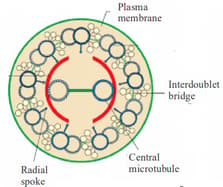The eukaryotic flagella and bacterial flagella differ from each other in that:
Important Questions on Biological Classification
Match the following?
| The list I | List II | ||
| (i) | Cellular extensions | (a) | Myonemes |
| (ii) | Whiplike organelles | (b) | Cilia |
| (iii) | Contractile fibrils | (c) | Pseudopodia |
| (iv) | Short hair-like organelles | (d) | Flagella |
Plasmid is a:
*None of the options were scientifically correct. Modified.*
Plasmids have the following characters.
i) They contain fewer genes than the bacterial chromosome.
ii) They have single stranded DNA
iii) They can be used as vectors
iv) They contain linear form of DNA
v) Plasmids confer protection to drugs
The correct combination is
Choose the correct statements
i. Ribosomes are found in Cytoplasm, Chloroplasts, Mitochondria and on rough ER
ii. Mesosomes in bacteria are not the sites of DNA replication
iii. Algae cell wall made of cellulose, galactans, mannan and calcium carbonate
iv. Mitochondria, chloroplast and peroxisomes are the part of Endomembrane System
The correct answer is
| List-I | List-II | List-III | |||
| A | Circular DNA | i | Sprouting out of cell | I | Attach the bacteria to the host tissue |
| B | Fimbriae | ii | Outermost layer of the cell wall | II | Solanaceae |
| C | Middle lamella | iii | Makoi | III | Plasmid DNA |
| D | Mesocarp and endocarp fused | iv | No nuclear membrane | IV | Develops from the cell plate |
The correct match is:
(A) Cytoplasm
(B) Plasma membrane
(C) Mitochondria
(D) Cellulose cell wall
(E) Meiotic cell division
In the below diagram, identify the part which connects the peripheral microtubules to the central sheath.


